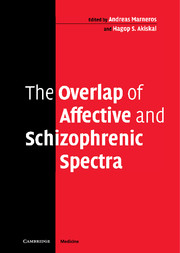Book contents
- Frontmatter
- Contents
- List of contributors
- Preface
- 1 The paradigma of overlapping affective and schizophrenic spectra: schizoaffective conditions
- 2 The overlapping of the spectra: overlapping genes and genetic models
- 3 The continuum of psychosis and its genetic basis
- 4 Functional psychoses: molecular-genetic evidence for a continuum
- 5 State- and trait-related deficits in sustained attention in bipolar disorder: are there any overlaps with schizophrenia?
- 6 The concept of schizoaffective disorder: utility versus validity and reliability – a transcultural perspective
- 7 Phenomenological approaches to the schizoaffective spectrum
- 8 Clinical course of schizoaffective disorders
- 9 Depressive syndromes in schizophrenia
- 10 The overlapping of the spectra: brief and acute psychoses
- 11 Overlapping of the spectra: physical comorbidity between schizophrenia and affective disorders
- 12 The overlapping of the spectra suicide
- 13 Biological treatment of schizoaffective disorders
- 14 Psychological therapies and schizoaffective disorders
- Epilogue: The interface of affective and schizophrenic disorders: a cross between two spectra?
- Index
4 - Functional psychoses: molecular-genetic evidence for a continuum
Published online by Cambridge University Press: 02 September 2009
- Frontmatter
- Contents
- List of contributors
- Preface
- 1 The paradigma of overlapping affective and schizophrenic spectra: schizoaffective conditions
- 2 The overlapping of the spectra: overlapping genes and genetic models
- 3 The continuum of psychosis and its genetic basis
- 4 Functional psychoses: molecular-genetic evidence for a continuum
- 5 State- and trait-related deficits in sustained attention in bipolar disorder: are there any overlaps with schizophrenia?
- 6 The concept of schizoaffective disorder: utility versus validity and reliability – a transcultural perspective
- 7 Phenomenological approaches to the schizoaffective spectrum
- 8 Clinical course of schizoaffective disorders
- 9 Depressive syndromes in schizophrenia
- 10 The overlapping of the spectra: brief and acute psychoses
- 11 Overlapping of the spectra: physical comorbidity between schizophrenia and affective disorders
- 12 The overlapping of the spectra suicide
- 13 Biological treatment of schizoaffective disorders
- 14 Psychological therapies and schizoaffective disorders
- Epilogue: The interface of affective and schizophrenic disorders: a cross between two spectra?
- Index
Summary
Background
The functional psychoses “schizophrenia,” “schizoaffective disorders,” “psychotic depression,” “bipolar illness,” and “atypical psychosis” are distinct diagnostic entities sharing a considerable overlap in their underlying clinical syndromes (Stassen et al., 1988; Maier et al., 1993; 1999; 2005; Faraone et al., 1995; Maziade et al., 1995, 2001; Scharfetter and Stassen, 1995; Loftus et al., 1998; Wildenauer et al., 1999; Berrettini, 2000; Pulver et al., 2000; Vogt et al., 2000; Vuoristo et al., 2000; Bailer et al., 2002; Glatt et al., 2003; Kendler, 2003; Schurhoff et al., 2003; Craddock et al., 2005). Across ethnicities, schizophrenia and bipolar illness each affect about one percent of the general population, causing the loss of the ability to work, to have close relationships, and to have a fulfilling life. Population frequencies appear to be largely independent of ethnicity and social factors, as suggested by numerous epidemiologic studies including the World Health Organization (WHO) program on the outcome of severe mental disorders (Jablensky et al., 1992), and the Epidemiologic Catchment Area (ECA) program on psychiatric epidemiology (Weissmann et al., 1988). However, physical and sociocultural environments may modify the course of functional psychoses since patients in developing countries have a more benign course than patients in developed countries (Leff et al., 1992).
- Type
- Chapter
- Information
- The Overlap of Affective and Schizophrenic Spectra , pp. 55 - 78Publisher: Cambridge University PressPrint publication year: 2006



